Evolution Prediction of Hysteresis Behavior of Sand under Cyclic Loading
Abstract
:1. Introduction
2. Details of the Decoupling Method
2.1. Determining the Elastic Curve
2.2. Decoupled Plastic Stress–Strain Curve
2.3. Implementation Procedures of Decoupling Method
3. Application in the Cyclic Triaxial Test (CTT)
3.1. Elastic Parameters E and v
3.2. Plastic Parameters Ep and vp
3.3. Simulation
4. Application in the Cyclic Isotropic Compression Test (CICT)
5. Application in Cyclic Oedometric Compression Tests (COCT)
6. Limitations of the Decoupling Method
7. Implications of This Work
8. Conclusions
Author Contributions
Funding
Institutional Review Board Statement
Informed Consent Statement
Data Availability Statement
Acknowledgments
Conflicts of Interest
References
- Puech, A.; Garnier, J. Introduction to cyclic degradation. In Design of Piles under Cyclic Loading: SOLCYP Recommendations; ISTE Ltd: London, UK; John Wiley and Sons: Hoboken, NJ, USA, 2017; pp. 41–99. [Google Scholar]
- Lei, H.; Li, B.; Lu, H.; Ren, Q. Dynamic Deformation Behavior and Cyclic Degradation of Ultrasoft Soil under Cyclic Loading. J. Mater. Civ. Eng. 2016, 28, 04016135. [Google Scholar] [CrossRef]
- Karg, C.; Haegeman, W. Elasto-plastic long-term behavior of granular soils: Experimental investigation. Soil Dyn. Earthq. Eng. 2009, 29, 155–172. [Google Scholar] [CrossRef]
- Wichtmann, T.; Niemunis, A.; Triantafyllidis, T. Strain accumulation in sand due to cyclic loading: Drained triaxial tests. Soil Dyn. Earthq. Eng. 2005, 25, 967–979. [Google Scholar] [CrossRef]
- Da Fonseca, A.V.; Rios, S.; Amaral, M.F.; Panico, F. Fatigue Cyclic Tests on Artificially Cemented Soil. Geotech. Test. J. 2013, 36. [Google Scholar] [CrossRef] [Green Version]
- Vitali, O.P.M.; Nassim, M.; Khasawneh, Y. Cyclic and Monotonic Behavior of Onshore Wind Turbine Foundation Systems in Cohesionless Ground. In Proceedings of the Geo-Congress 2022, Charlotte, NC, USA, 20–23 March 2022; pp. 228–237. [Google Scholar] [CrossRef]
- Yang, Q.; Ren, Y.; Niu, J.; Cheng, K.; Hu, Y.; Wang, Y. Characteristics of soft marine clay under cyclic loading: A review. Bull. Eng. Geol. Environ. 2017, 77, 1027–1046. [Google Scholar] [CrossRef]
- Chen, W.F.; Han, D.J. Plasticity for Structural Engineers; J. Ross Publishing: Plantation, FL, USA, 2007. [Google Scholar]
- Yu, H.-S.; Khong, C.; Wang, J. A unified plasticity model for cyclic behaviour of clay and sand. Mech. Res. Commun. 2007, 34, 97–114. [Google Scholar] [CrossRef]
- Zhang, X.; Lytton, R.L. Modified state-surface approach to the study of unsaturated soil behavior. Part II: General formulation. Can. Geotech. J. 2009, 46, 553–570. [Google Scholar] [CrossRef]
- Zhang, X.; Lytton, R.L. Modified state-surface approach to the study of unsaturated soil behavior. Part I: Basic concept. Can. Geotech. J. 2009, 46, 536–552. [Google Scholar] [CrossRef]
- Iwan, W.D. On a Class of Models for the Yielding Behavior of Continuous and Composite Systems. J. Appl. Mech. 1967, 34, 612–617. [Google Scholar] [CrossRef]
- Mróz, Z. On the description of anisotropic workhardening. J. Mech. Phys. Solids 1967, 15, 163–175. [Google Scholar] [CrossRef]
- Maleki, M.; Cambou, B.; Dubujet, P. Development in modeling cyclic loading of sands based on kinematic hardening. Int. J. Numer. Anal. Methods Géoméch. 2009, 33, 1641–1658. [Google Scholar] [CrossRef]
- Oka, F.; Yashima, A.; Kato, M.; Sekiguchi, K. A constitutive model for sand based on the non-linear kinematic hardening rule and its application. In Proceedings of the 10th World Conference Earthquake Engineering, Madrid, Spain, 19–24 July 1992; pp. 2529–2534. [Google Scholar]
- Hashiguchi, K. Mechanical requirements and structures of cyclic plasticity models. Int. J. Plast. 1993, 9, 721–748. [Google Scholar] [CrossRef]
- Heidarzadeh, H.; Oliaei, M. Development of a generalized model using a new plastic modulus based on bounding surface plasticity. Acta Geotech. 2017, 13, 925–941. [Google Scholar] [CrossRef]
- Dafalias, Y.F.; Herrmann, L.R. Bounding Surface Plasticity. II: Application to Isotropic Cohesive Soils. J. Eng. Mech. 1986, 112, 1263–1291. [Google Scholar] [CrossRef]
- Bardet, J.P. Bounding Surface Plasticity Model for Sands. J. Eng. Mech. 1986, 112, 1198–1217. [Google Scholar] [CrossRef]
- Zienkiewicz, O.C.; Mroz, Z. Generalized plasticity formulation and applications to geomechanics. Mech. Eng. Mater. 1984, 44, 655–680. [Google Scholar]
- Ling, H.I.; Yang, S. Unified Sand Model Based on the Critical State and Generalized Plasticity. J. Eng. Mech. 2006, 132, 1380–1391. [Google Scholar] [CrossRef]
- Hardin, B.O.; Blandford, G.E. Elasticity of Particulate Materials. J. Geotech. Eng. 1989, 115, 788–805. [Google Scholar] [CrossRef]
- Hashiguchi, K. Subloading surface model in unconventional plasticity. Int. J. Solids Struct. 1989, 25, 917–945. [Google Scholar] [CrossRef]
- Sawicki, A.; Świdziński, W. Elastic moduli of non-cohesive particulate materials. Powder Technol. 1998, 96, 24–32. [Google Scholar] [CrossRef]
- Niemunis, A.; Wichtmann, T.; Triantafyllidis, T. A high-cycle accumulation model for sand. Comput. Geotech. 2005, 32, 245–263. [Google Scholar] [CrossRef]
- Tatsuoka, F.; Shibuya, S. Deformation characteristics of soils and rocks from field and laboratory tests. In Proceedings of the 9th Asian Regional Conference on Soil Mechanics and Foundation Engineering, Bangkok, Thaliland, 9–13 December 1992; pp. 101–170. [Google Scholar]
- Gu, X.; Yang, J.; Huang, M. Laboratory measurements of small strain properties of dry sands by bender element. Soils Found. 2013, 53, 735–745. [Google Scholar] [CrossRef]
- Cuccovillo, T.; Coop, M.R. Yielding and pre-failure deformation of structured sands. Geotechnique 1997, 47, 491–508. [Google Scholar] [CrossRef]
- Tatsuoka, F.; Jardine, R.J.; Presti, D.L.; Benedetto, H.D.; Kodaka, T. Characterising the pre-failure deformation properties of geomaterials. In Proceedings of the Fourteenth International Conference on Soil Mechanics and Foundation Engineering, Hamburg, Germany, 6–12 September 1997; Balkema, A.A., Ed.; The National Academies of Sciences, Engineering, and Medicine: Washington, DC, USA, 1997; pp. 1–36. [Google Scholar]
- Ezaoui, A.; Benedetto, H. Experimental measurements of the global anisotropic elastic behaviour of dry Hostun sand during triaxial tests, and effect of sample preparation. Géotechnique 2009, 59, 621–635. [Google Scholar] [CrossRef]
- Gu, X.; Yang, J.; Huang, M. DEM simulations of the small strain stiffness of granular soils: Effect of stress ratio. Granul. Matter 2013, 15, 287–298. [Google Scholar] [CrossRef]
- Hoque, E.; Tatsuoka, F. Anisotropy in Elastic Deformation of Granular Materials. Soils Found. 1998, 38, 163–179. [Google Scholar] [CrossRef] [Green Version]
- Hoque, E.; Tatsuoka, F. Effects of stress ratio on small-strain stiffness during triaxial shearing. Géotechnique 2004, 54, 429–440. [Google Scholar] [CrossRef]
- Chen, Y.-C.; Ishibashi, I.; Jenkins, J.T. Dynamic shear modulus and fabric: Part I, depositional and induced anisotropy. Géotechnique 1988, 38, 25–32. [Google Scholar] [CrossRef]
- Drnevich, V.; Hardin, B.; Shippy, D. Modulus and damping of soils by the resonant-column method. In Dynamic Geotechnical Testing; ASTM International: West Conshohocken, PA, USA, 1978. [Google Scholar] [CrossRef]
- Knodel, P.; Thomann, T.; Hryciw, R. Laboratory Measurement of Small Strain Shear Modulus Under K0 Conditions. Geotech. Test. J. 1990, 13, 97. [Google Scholar] [CrossRef]
- Yang, J.; Gu, X. Shear stiffness of granular material at small strains: Does it depend on grain size? Géotechnique 2013, 63, 165–179. [Google Scholar] [CrossRef] [Green Version]
- Bellotti, R.; Jamiolkowski, M.; Presti, D.L.; O’Neill, D.A. Anisotropy of small strain stiffness in Ticino sand. Géotechnique 1996, 46, 115–131. [Google Scholar] [CrossRef]
- Jia, X.; Caroli, C.; Velicky, B. Ultrasound Propagation in Externally Stressed Granular Media. Phys. Rev. Lett. 1999, 82, 1863–1866. [Google Scholar] [CrossRef] [Green Version]
- Sharifipour, M.; Dano, C.; Hicher, P.-Y. Wave velocities in assemblies of glass beads using bender-extender elements. In Proceedings of the 17th ASCE Engineering Mechanics Conference, Newark, NJ, USA, 13–16 June 2004; pp. 1–8. [Google Scholar]
- Hicher, P.Y. Elastic properties of soils. J. Geotech. Eng. 1996, 122, 641–648. [Google Scholar] [CrossRef]
- Xia, P.; Shao, L.; Deng, W. Mechanism study of the evolution of quasi-elasticity of granular soil during cyclic loading. Granul. Matter 2021, 23, 84. [Google Scholar] [CrossRef]
- Chen, C.; Indraratna, B.; McDowell, G.; Rujikiatkamjorn, C. Discrete element modelling of lateral displacement of a granular assembly under cyclic loading. Comput. Geotech. 2015, 69, 474–484. [Google Scholar] [CrossRef]
- Indraratna, B.; Thakur, P.K.; Vinod, J.S. Experimental and Numerical Study of Railway Ballast Behavior under Cyclic Loading. Int. J. Géoméch. 2010, 10, 136–144. [Google Scholar] [CrossRef]
- Nguyen, N.-S.; François, S.; Degrande, G. Discrete modeling of strain accumulation in granular soils under low amplitude cyclic loading. Comput. Geotech. 2014, 62, 232–243. [Google Scholar] [CrossRef]
- Zeng, F.; Shao, L. Unloading Elastic Behavior of Sand in Cyclic Triaxial Tests. Geotech. Test. J. 2016, 39, 20150171. [Google Scholar] [CrossRef]
- Xia, P.; Zeng, C.; Shao, L.; Zhang, X.; Guo, X. Axial component of plastic modulus of sand under slow periodic load. J. GeoEng. 2021, 16, 47–59. [Google Scholar] [CrossRef]
- Xia, P.; Deng, W.; Shao, L.; Zhang, X. Role of elastic upper limit in shakedown study for granular soils. Transp. Geotech. 2022, 34, 100746. [Google Scholar] [CrossRef]
- Pradhan, T.B.; Tatsuoka, F.; Sato, Y. Experimental Stress-Dilatancy Relations of Sand Subjected to Cyclic Loading. Soils Found. 1989, 29, 45–64. [Google Scholar] [CrossRef] [Green Version]
- Hicher, P.; El Hosri, M.; Homsi, M. Cyclic Properties of Soils Within a Large Range of Strain Amplitude. Soils Found. 1987, 365–378. [Google Scholar] [CrossRef]
- Sharma, S.S.; Fahey, M. Degradation of Stiffness of Cemented Calcareous Soil in Cyclic Triaxial Tests. J. Geotech. Geoenvironmental Eng. 2003, 129, 619–629. [Google Scholar] [CrossRef]
- Pincus, H.; Tatsuoka, F.; Sato, T.; Park, C.-S.; Kim, Y.-S.; Mukabi, J.; Kohata, Y. Measurements of Elastic Properties of Geomaterials in Laboratory Compression Tests. Geotech. Test. J. 1994, 17, 80. [Google Scholar] [CrossRef]
- Chang, C.S. Compressibility for sand under one-dimensional loading condition. Proc. Settl. Geotech. Spec. Publiccation 1994, 1, 1298–1311. [Google Scholar]
- Hardin, B.O. The nature of stress-strain behavior for soils. In Proceedings of the ASCE Geotechnical Engineering Division Specialty Conference, Honolulu, HI, USA, 11–15 January 1978; pp. 3–90. [Google Scholar]
- Xia, P.; Zeng, C.; Shao, L.; Zhang, X. Axial strain accumulation projection model for sand in cyclic loading. Soil Dyn. Earthq. Eng. 2021, 147, 106819. [Google Scholar] [CrossRef]
- Sun, Y.; Shao, L.; Fan, Z. Experimental research on Poisson’s ratio of sandy soil. Rock Soil Mech. 2009, 30 (Suppl. S1), 433–438. [Google Scholar] [CrossRef]
- Zhao, Y.; Mahmood, N.S.; Coffman, R.A. Small-Strain and Large-Strain Modulus Measurements with a Consolidation Device. J. Test. Eval. 2018, 47. [Google Scholar] [CrossRef]
- Duncan, J.M.; Chang, C.Y. Nonlinear analysis of stress and strain in soils. J. Soil Mech. Found. Div. 1970, 96, 1629–1653. [Google Scholar] [CrossRef]
- Xia, P.; Shao, L.; Deng, W. Stress-state dependency of the strain ratio of quasi-elastic granular soils under cyclic loading. Geotechnique, 2021; under review. [Google Scholar]
- Liu, Z.; Wang, R.; Zhao, G. Plastic Poisson’s ratio and elastic-plastic Poisson’s ratio of material. J. Plast. Eng. 1999, 6, 26–29. [Google Scholar]
- Qubain, B.S.; Kaliakin, V.N.; Martin, J.P. Variable bulk modulus constitutive model for sand. J. Geotech. Geoenviron. Eng. 2003, 129, 158–162. [Google Scholar] [CrossRef]
- García, X.; Medina, E. Hysteresis effects studied by numerical simulations: Cyclic loading-unloading of a realistic sand model. GEOPHYSICS 2006, 71, F13–F20. [Google Scholar] [CrossRef]
- Wichtmann, T.; Triantafyllidis, T. An experimental database for the development, calibration and verification of constitutive models for sand with focus to cyclic loading: Part II—Tests with strain cycles and combined loading. Acta Geotech. 2016, 11, 763–774. [Google Scholar] [CrossRef]
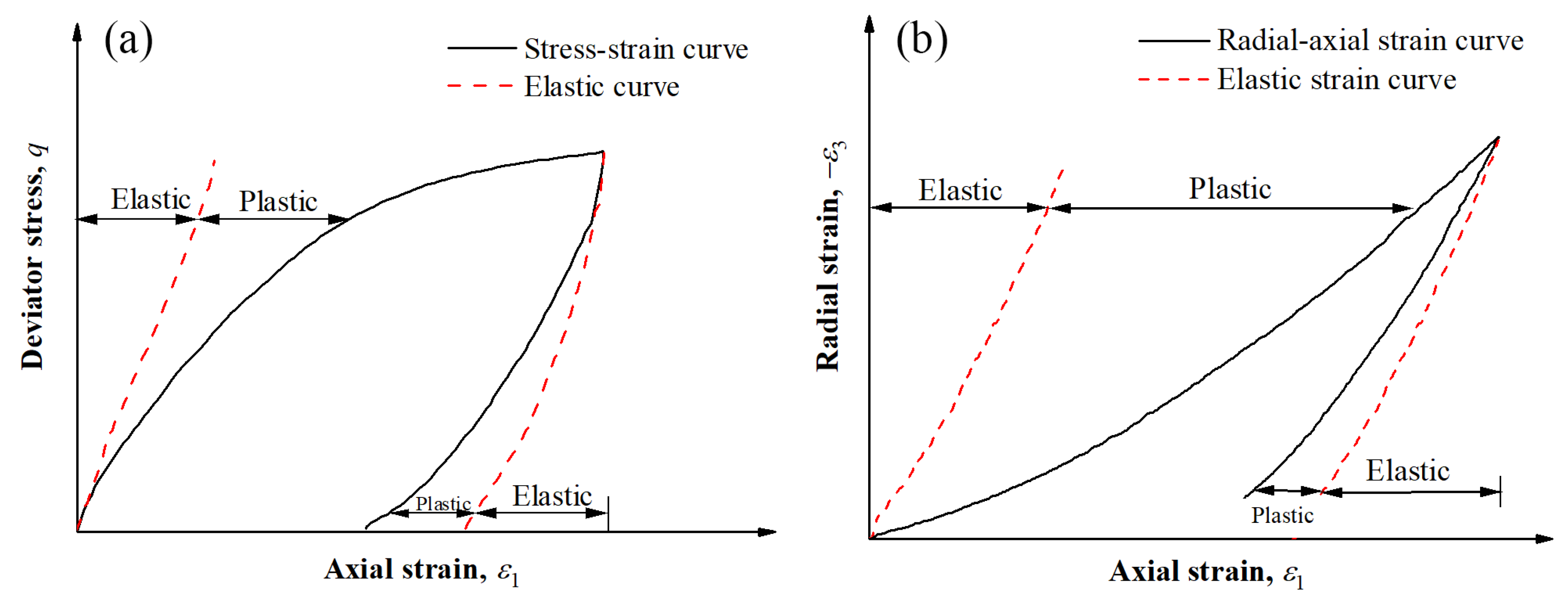
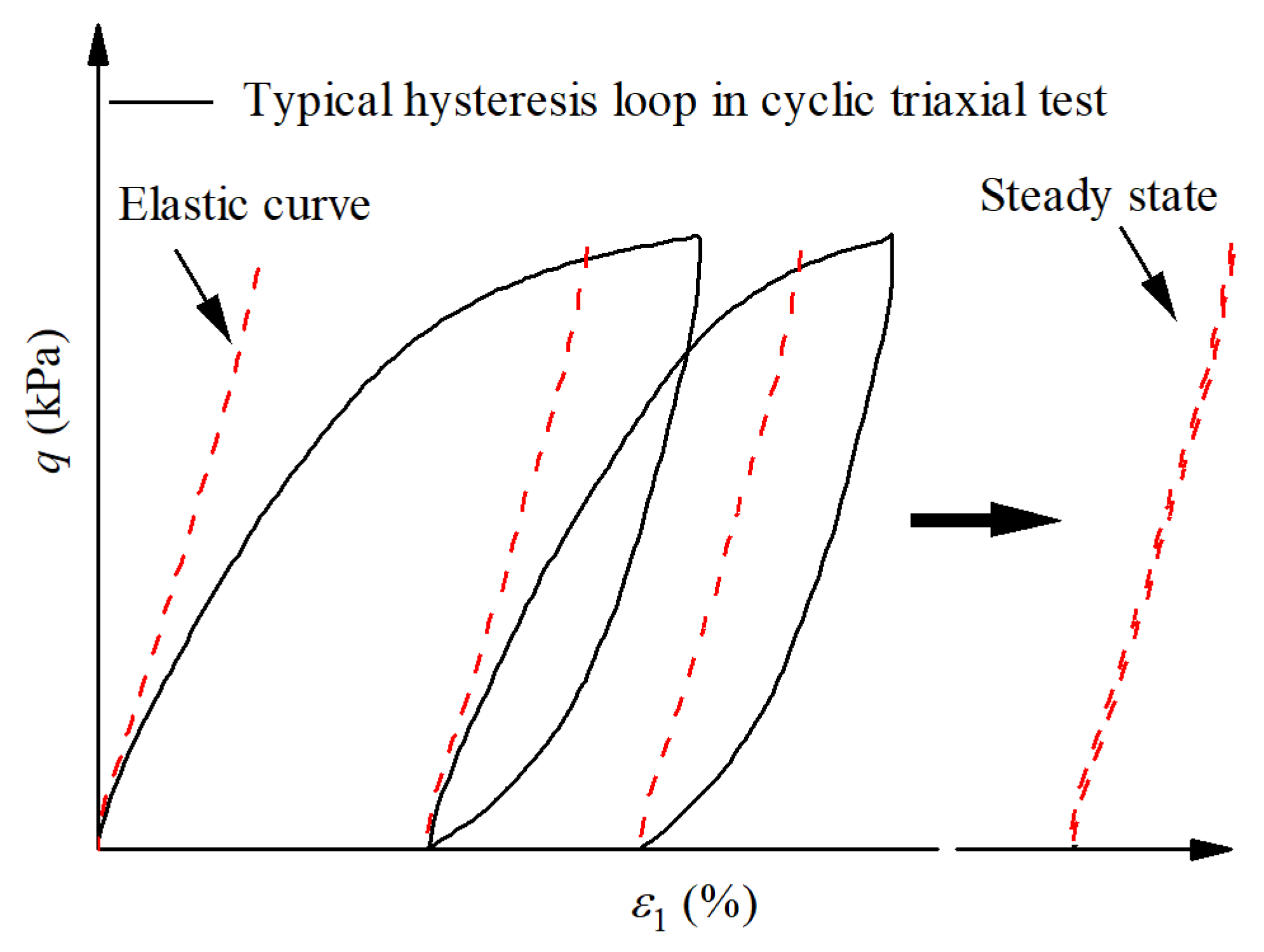

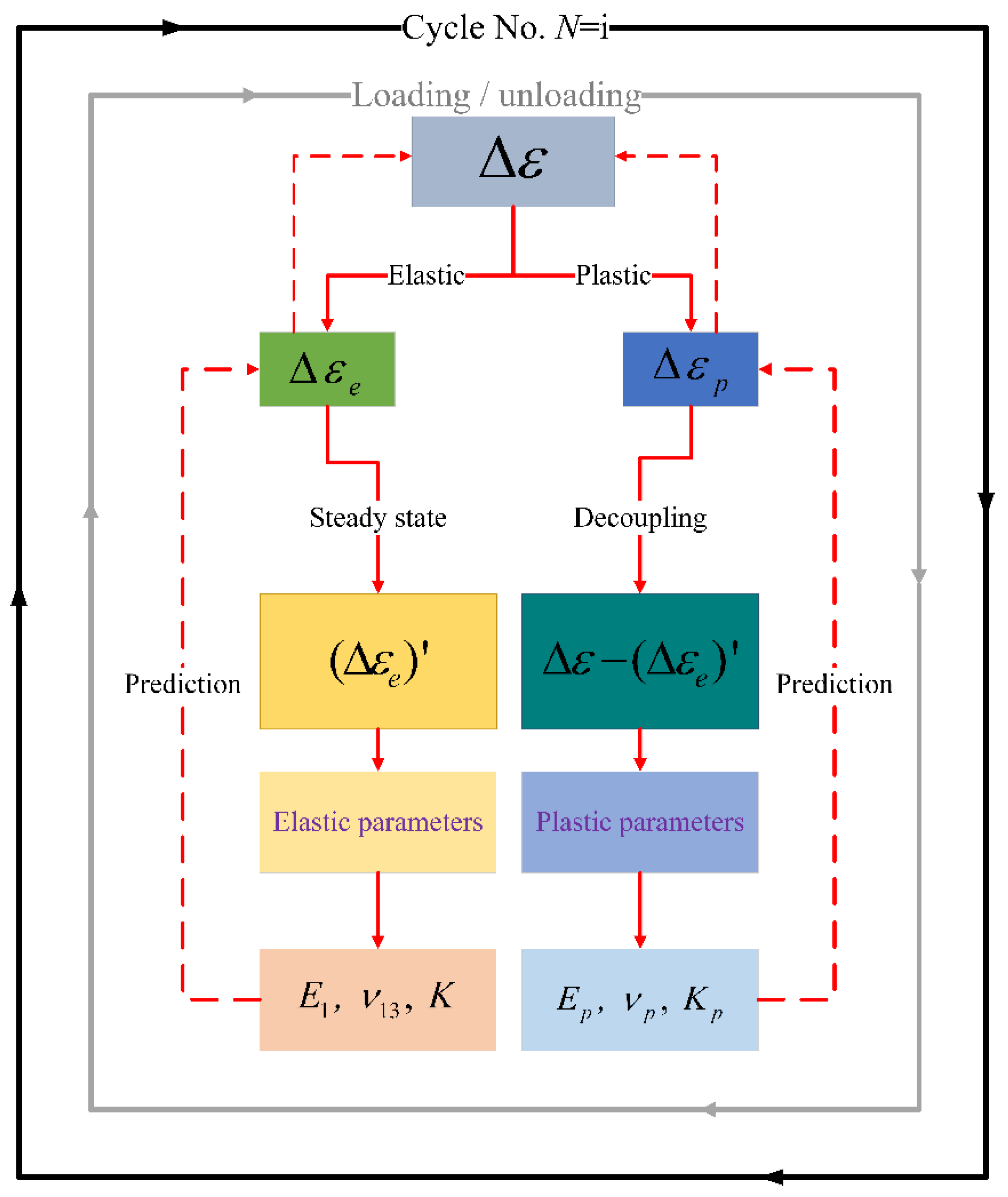

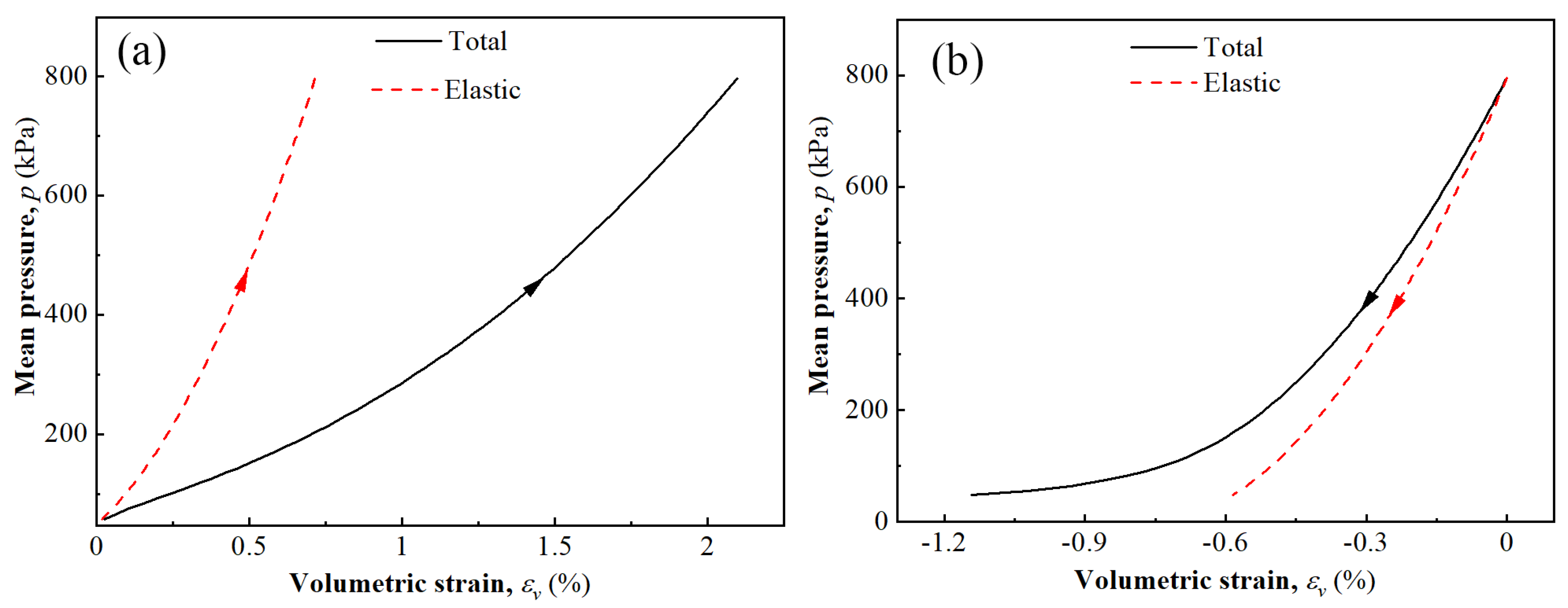

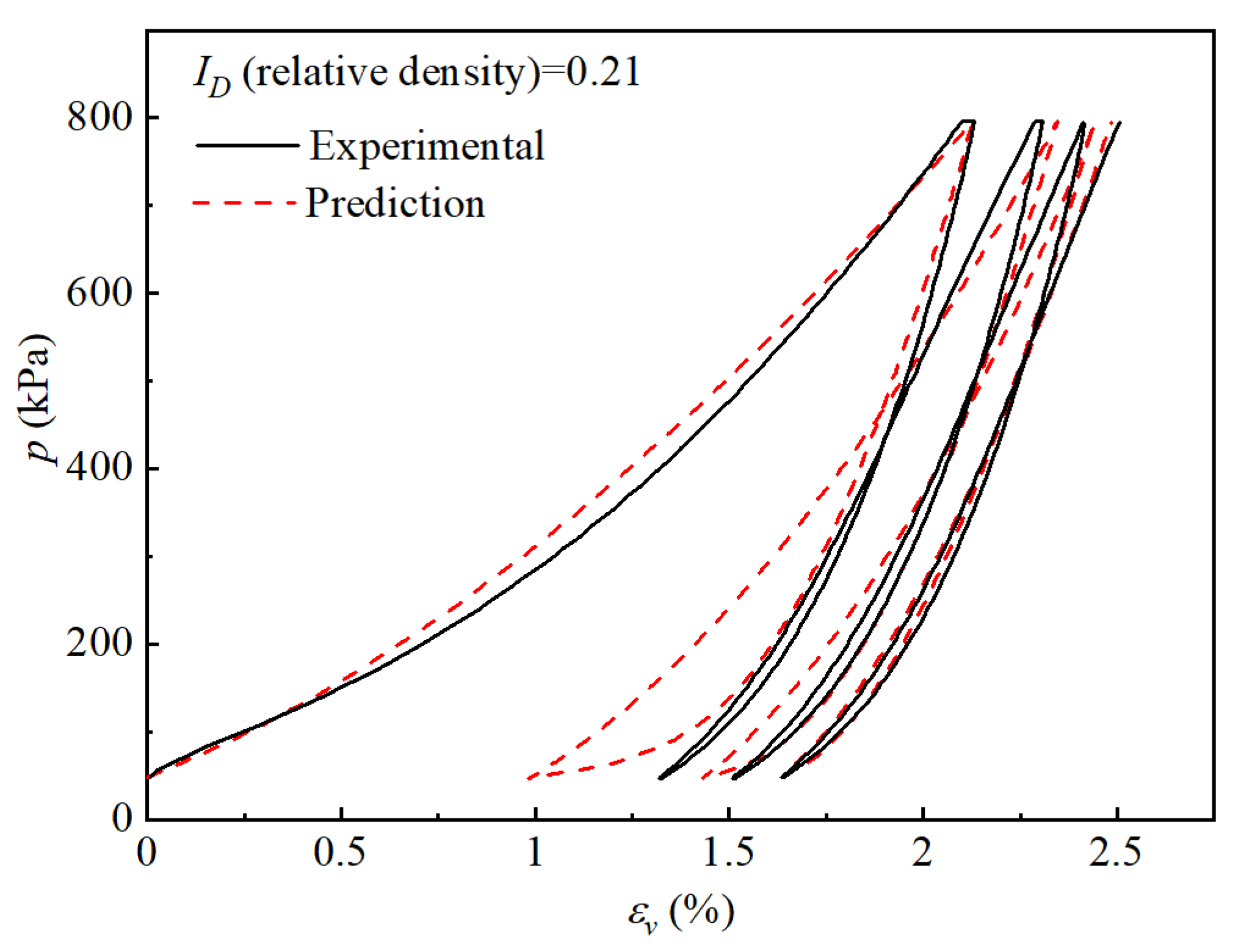

| CTT | Parameter | α | |||||
| Value | 33.8 | 2.5 | 0.35 | 0.016 | −4.9/15.2 | 310/3.2 | |
| Parameter | |||||||
| Value | 0.24/0.13 | 0.13/0.02 | 0.17/0.32 | 0.001/0.15 | 4.8/12 | ||
| CITC | Parameter | |||||
| Value | 2312 | 2149 | 491 | 0.34 | 1.63/6.35 |
| COCT | Parameter | α | |||||
| Value | 120 | 328 | 110/2000 | 0.6/10 | 0.01/0.01 | 0.3/0.3 |
Publisher’s Note: MDPI stays neutral with regard to jurisdictional claims in published maps and institutional affiliations. |
© 2022 by the authors. Licensee MDPI, Basel, Switzerland. This article is an open access article distributed under the terms and conditions of the Creative Commons Attribution (CC BY) license (https://creativecommons.org/licenses/by/4.0/).
Share and Cite
Xia, P.; Shao, L.; Deng, W.; Zeng, C. Evolution Prediction of Hysteresis Behavior of Sand under Cyclic Loading. Processes 2022, 10, 879. https://doi.org/10.3390/pr10050879
Xia P, Shao L, Deng W, Zeng C. Evolution Prediction of Hysteresis Behavior of Sand under Cyclic Loading. Processes. 2022; 10(5):879. https://doi.org/10.3390/pr10050879
Chicago/Turabian StyleXia, Pingxin, Longtan Shao, Wen Deng, and Chao Zeng. 2022. "Evolution Prediction of Hysteresis Behavior of Sand under Cyclic Loading" Processes 10, no. 5: 879. https://doi.org/10.3390/pr10050879






